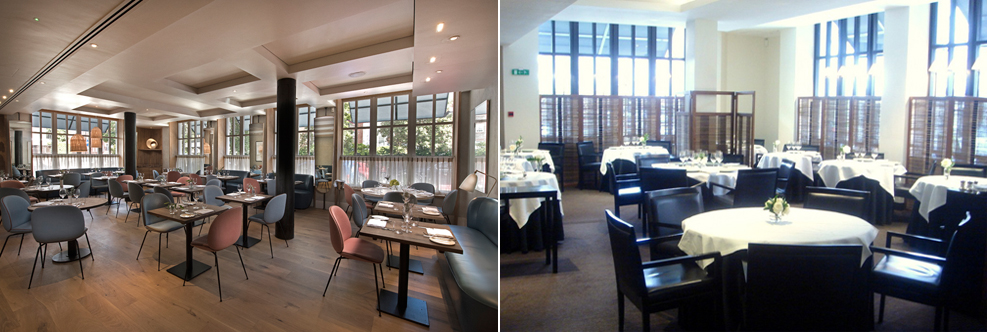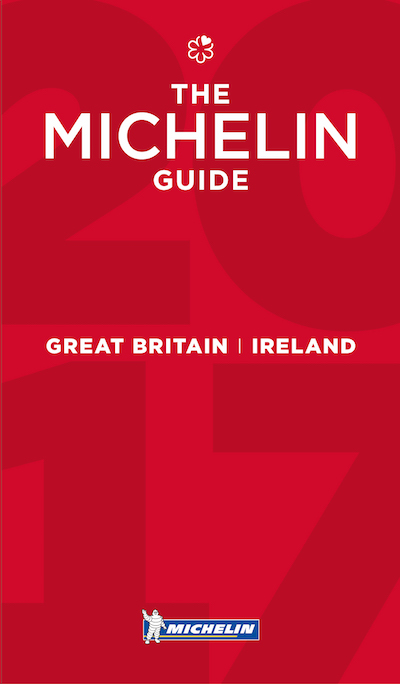 Interview with Michelin Guide GB&I 2017 Editor, Rebecca Burr, conducted by Simon Carter on October 3rd 2017 at IET, Savoy Place. Fine Dining Guide Editorial comment on the launch event and guide content.
Interview with Michelin Guide GB&I 2017 Editor, Rebecca Burr, conducted by Simon Carter on October 3rd 2017 at IET, Savoy Place. Fine Dining Guide Editorial comment on the launch event and guide content.
Congratulations on Michelin GB&I delivering a first live launch event!
We’re delighted to have delivered a first live launch event, there’s certainly a lot to maneuver, a first time in GB&I so everything is new, sometimes challenging but exciting in equal measures. Such events have proven successful in many of the other geographies, primarily in Asia, and certainly in Spain and Germany. It is year one for us and from what I saw it went well.
What were the logistics like?
Logistically events like this are challenging, it is not a Michelin Guide event without chefs so we are extremely grateful for the sacrifices many chefs have made in travelling to London, some at very short notice, and some quite long journeys, to participate in this event.
Tell us about the two new sponsored awards?
There has always naturally been an attraction to the Michelin Guide for potential sponsors due to the strong reputation, fierce independence, unerring commitment to quality and the representation of a certain lifestyle. The commercial arm of the company have teamed up with some very professional people to deliver two awards this year where the recipients have been determined by our team of inspectors.
The Michelin Female Chef 2017 award winner is a reflection of Clare Smyth’s dedication to maintaining (and ever evolving) the standards of a Michelin three star address at Restaurant Gordon Ramsay. In terms of The Michelin Service and Welcome Award 2017 the inspection team felt Peel’s at Hampton Manor (also in receipt of their first Michelin star) was the right 2017 recipient of this award.
Hampton Manor is essentially a business hotel located not too far from Birmingham airport with many corporate events going on, the restaurant offering has been thoughtfully and carefully tweaked to reflect the scope of their customer base and Michelin were happy to recognize their achievements is getting every aspect of service and welcome right for their customers.
How do you see the current industry trends?
In terms of state of play and trends in the industry, to demonstrate by examples, when (as a team) we looked at the candidates for a Michelin star we found a clear and broad variety of restaurant that reflected the diversity of the modern market place: From Veeraswamy to The Ritz through to Ellory and The Ninth. This was nothing contrived, it was purely about the natural flow of a decision making process determined by strict criteria. I mention these purely to reflect how vibrant and diverse the dining scene is around the country.
Was it a big decision to award The Fat Duck a regained three Michelin stars?
We thought it was a completely right decision to reintroduce the Fat Duck at three stars for the 2017 Michelin GB&I Guide. We knew when the restaurant closed that The Fat Duck had plans for changes, evolutions and developments in the offering so we felt to be true to our principles it was right not to include the restaurant in the Michelin Guide 2016. However, having reviewed the situation rigorously and most carefully, it was completely the right decision to re-instate the three stars for Michelin Guide GB&I 2017.
The Michelin GB&I on twitter is widely talked about, what is your thinking there..
In terms of the social media: The Michelin Guide is produced once a year and while we are already working on the new guide, an idea of where we are visiting plus occasional opinions may be found on twitter. The concept of posting some pictures and making a descriptive comment on where we have visited is a useful standard in so far as it goes. Michelin are a little bolder in that occasionally we offer a value added statement that reflects the opinion of the inspector. We don’t take this responsibility lightly and are careful in its application.
The decision is simple, to back ourselves in our expertise of the opinion! As you might expect, sometimes we find restaurants deliver very good food and other times the results are not always perfect. In terms of the latter we follow rules to be careful and sensitive, we are not here to tabloid sensationalize, neither to name and shame nor in any way to make a chef who has put in a 16 hour working shift, feel he is looking up the Michelin twitter page to see which chef has been knocked by Michelin.
Having said this, Michelin do believe in carefully reflecting important information that is not always rosy, for example, an ingredient combination may not work, or where a restaurant may have missed something at check-in. At the same time there’s plenty of good news opinions to reflect: A fellow table commenting that a restaurant is worthy of a star, which from the meal eaten could be confirmed (Gilpin) or beautifully constructed dishes using the best of ingredients.
Overall the Michelin GB&I twitter has proven very popular with chefs and readers as well as useful for disseminating information to a broadly interested audience. This will continue.
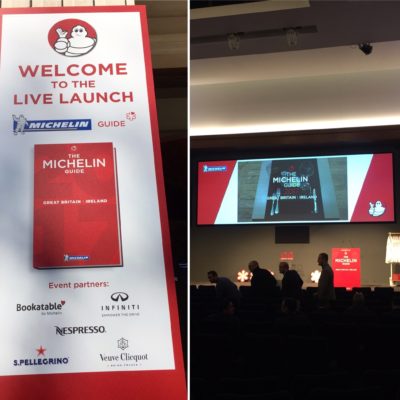
Fine Dining Guide Comment: Siân Jones http://sian-jones.com/ hosted the first ever live launch event for the Michelin GB&I Guide 2017. The event took place on October 3rd 2016 in the auditorium of IET (Institute of Engineering Technology) in Savoy Place, London. Siân handed over to key Michelin executives during the ceremony: Claire Dorland-Clauzel, Executive Board Member of the Michelin Group (very senior indeed!) and Michael Ellis, International Director of the Michelin Guides (Executive to the lead (Managing) Guide editors across geographies – Europe, Asia and Americas).
Michael Ellis started proceedings with an effortless, understated delivery, which seemed completely in keeping with the image of Michelin to industry watchers. This was no surprise, having interviewed Mr Ellis the primary impression of intelligent and professionally clear, articulate communication was confirmed.
So having initially spoken briefly about the mantra of consistency, including consistency in the ‘value’ of a star worldwide (much debated by GB&I starred chefs who travel the world dining) and also of the importance of the Guide in reflecting new dining trends back to readers.
From time to time, handing back and forth with Siân Jones, who possibly displayed a more – as Siân’s website may suggest – ‘motivational’ approach was perhaps more enthusiastic than required for this type of event while still managing a fair job.
The invitation only audience was made up of representatives from the pool of accepted invites, which had been extended to all the one star restaurants in London, all of the GB&I two and three star restaurants plus some restaurants that would be awarded stars during the event. There was also a gathering of press at the back of the auditorium. The event was filmed and screened live over the web via http://marketing.michelin.co.uk/guide2017/
Two sponsored awards were given, each with an introduction by an executive of the sponsor – Michelin Female Chef 2017 (Veuve Clicquot) and Michelin Service and Welcome Award 2017 (Nespresso). Clare Smyth (MBE) and Peel’s of Hampton Manor were the respective winners
Those restaurants that retained stars in spite of a change of circumstances – new chef for instance – were celebrated – these included Michael Wignall at Gidleigh Park who retained two stars at that address having moved from The Latymer at Pennyhill Park which had also held two Michelin stars. Heston Blumenthal at The Fat Duck regained three stars after a one year hiatus. All the existing two stars and one stars present also retained their accolades.
Then came the new star announcements of the ceremony. Beautifully done. A plan view of a map of GB&I produced on the large video screen zoomed into a location which then transformed to the page in the Michelin Guide GB&I 2017 that gave the name and details of the newly awarded entrant. Each chef then came to the stage to receive their commemorative chef’s whites and be photographed with Michael Ellis, a large Michelin Star, and the Michelin Man in full costume.
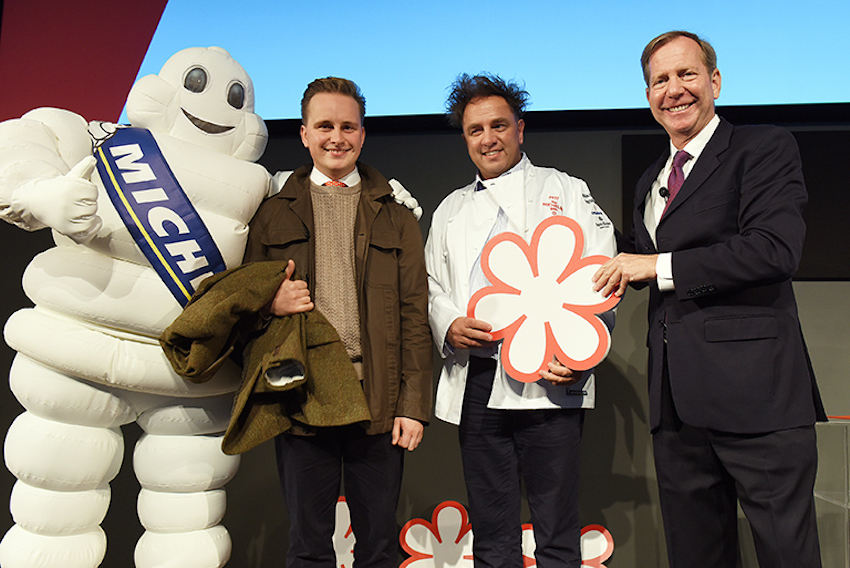
Then came the award of a new two Michelin star to Raby Hunt, which proved a popular decision. In the absence of other new two stars nor a new three star this concluded the event.
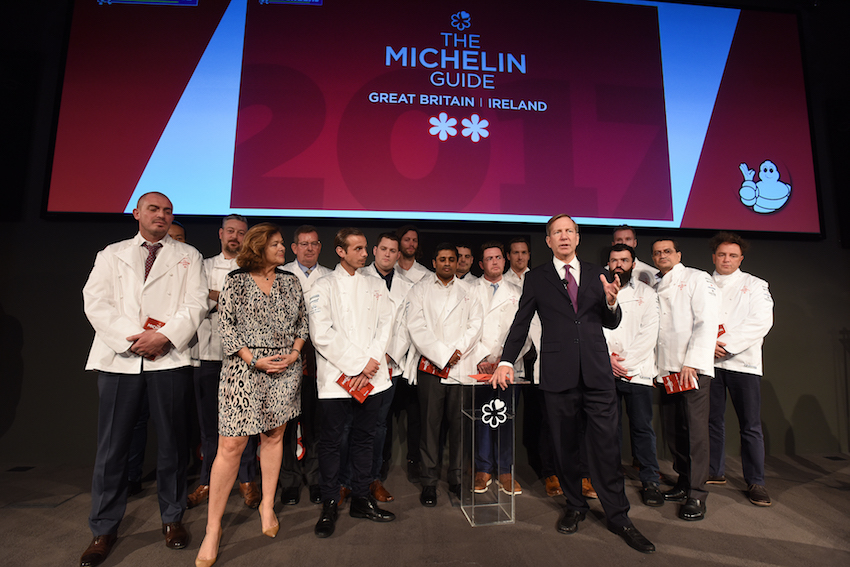
Overall Bright Consultancy (contact Louise Hall) in conjunction with the Michelin PR department (contact Dave Johnson) pulled off a strong event. Logistically getting the complete set of newly starred chefs to the event at very short notice must have been very challenging. In addition for a first time event, some teething troubles were to be expected but they can take away satisfaction at the 90% that went very well.
Content wise there were always those you would dearly love to have seen awarded a star that don’t quite get there for 2017 Guide. Each year also seems to see a star deletion that you didn’t see coming. Further Michelin Guide GB&I 2017 saw only one new two star and no new three stars – may this mean that Michelin are treading a conservative line a little too much? The industry is craving good news and recognition for homegrown talent all over the region.
In reality the three news stories of the Michelin Red Guide in GB&I this side of the millennium have been the meteoric rise of The Fat Duck to three Michelin Stars, the rise of The Hand and Flowers with chef Tom Kerridge to two Michelin stars (for a pub, a GB&I unique selling point) and Alain Ducasse being awarded three Michelin stars at The Dorchester (was that actually seven guides ago?)
For a guide that helps feed the readers of the nation well, do they feed the industry they serve enough? The twitter presence is a massive positive step, very well received and cleverly implemented. Digital apps are useful and events like these help, too. The inevitability of the commercial link-ups with booking systems through to lifestyle brands must be seen as funding the resources that help to protect and retain integrity rather than challenging it!
With the on-line, dynamic and ever faster changing world, reflected through tastes and restaurant offerings changing, at an ever greater pace, what else will Michelin do to retain their forefront position? Perhaps, as ever, we’ll all wait and see with baited breath and in particular for next autumn!




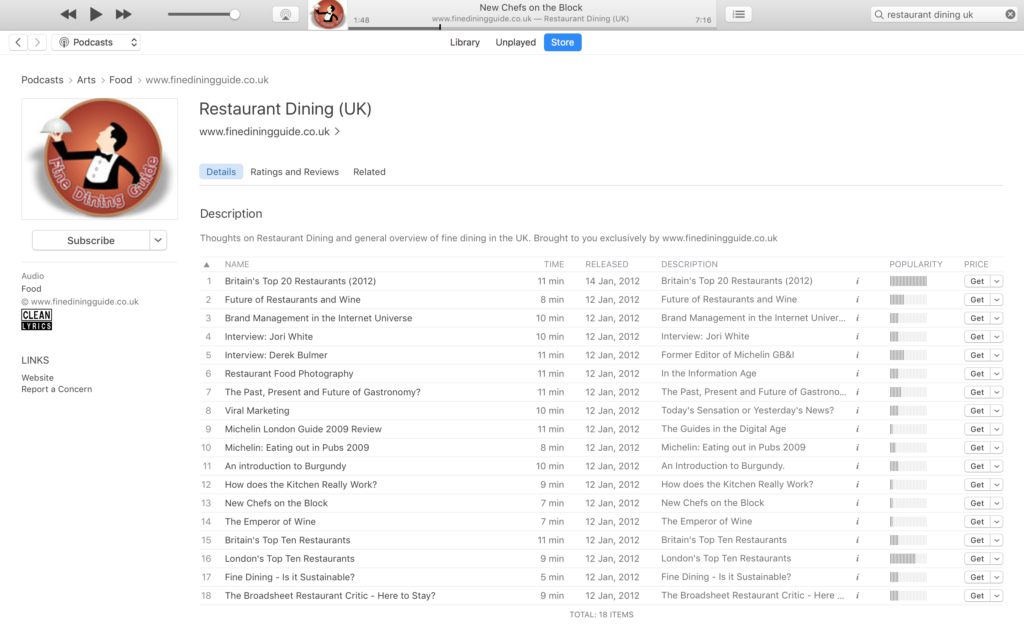 fine-dining-guide continues to have a
fine-dining-guide continues to have a 



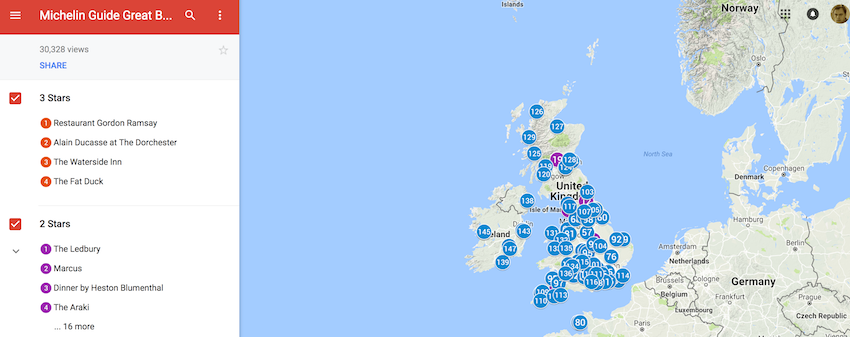

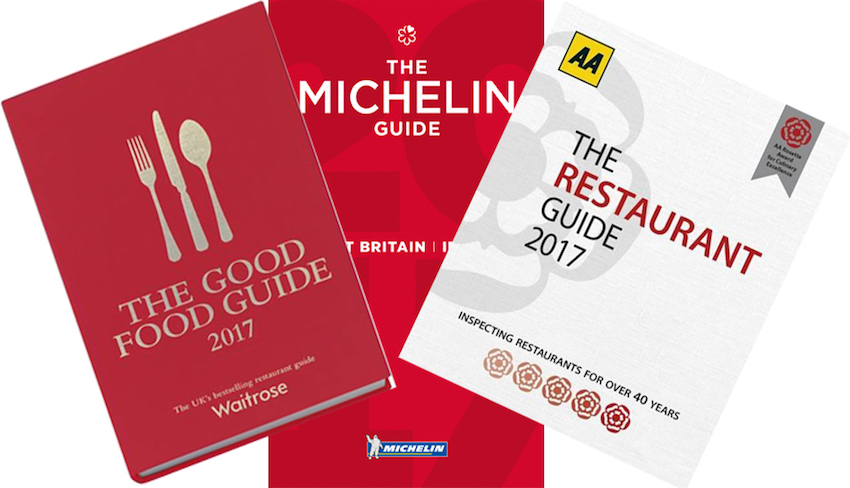
 Interview with Michelin Guide GB&I 2017 Editor, Rebecca Burr, conducted by Simon Carter on October 3rd 2017 at IET, Savoy Place. Fine Dining Guide Editorial comment on the launch event and guide content.
Interview with Michelin Guide GB&I 2017 Editor, Rebecca Burr, conducted by Simon Carter on October 3rd 2017 at IET, Savoy Place. Fine Dining Guide Editorial comment on the launch event and guide content.


 In the unique “language” of the Michelin Guide, the Bib symbols indicate the inspectors’ favourite establishments, offering high-quality products and services and good value for the money.
In the unique “language” of the Michelin Guide, the Bib symbols indicate the inspectors’ favourite establishments, offering high-quality products and services and good value for the money.
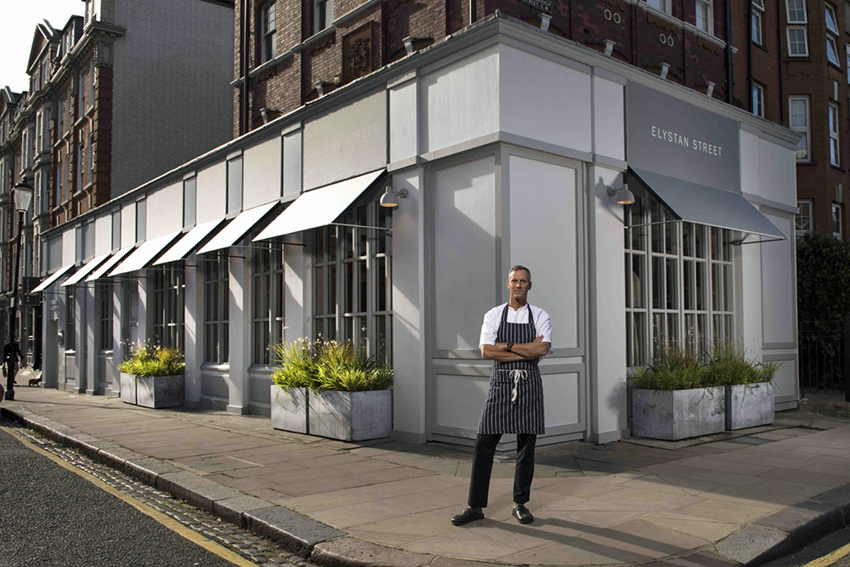
 So we have to look, listen, reflect and create menus with elements that are lighter, cleaner, perhaps more vegetarian influenced. You might find demand for less dairy or gluten but when looking at the menu you perhaps wouldn’t notice these attributes, however some subtlety of thought has gone into that, particularly at lunch time. So to feature salads, Carpaccios, certain raw foods and so on will be items taken on board as a conscious decision, however there will also be provision along side these dishes for tastes that are looking for more ‘destination’ style food.
So we have to look, listen, reflect and create menus with elements that are lighter, cleaner, perhaps more vegetarian influenced. You might find demand for less dairy or gluten but when looking at the menu you perhaps wouldn’t notice these attributes, however some subtlety of thought has gone into that, particularly at lunch time. So to feature salads, Carpaccios, certain raw foods and so on will be items taken on board as a conscious decision, however there will also be provision along side these dishes for tastes that are looking for more ‘destination’ style food.